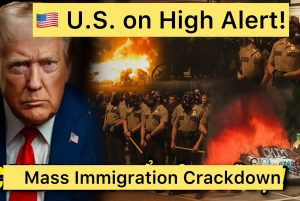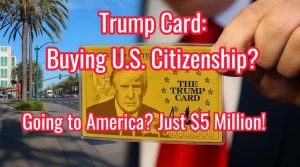Trump Card: $5 Million for U.S. Citizenship – Golden Opportunity or Political Illusion?

Trump Card: $5 Million for U.S. Citizenship – Golden Opportunity or Political Illusion?
In a move that has stunned both the American public and the international community, President Donald Trump’s administration has unveiled a groundbreaking immigration proposal — the Trump Card, a program that offers wealthy foreigners a chance to live and eventually become U.S. citizens by investing $5 million.
In just a matter of days, over 70,000 people have already signed up for the waiting list on the official portal TrumpCard.gov — with the majority coming from Asia, the Middle East, and India.
But what is the Trump Card really?
Is it a legitimate pathway to the American Dream — or simply a political play wrapped in golden packaging?
Let’s dive deep into the story that’s dominating global headlines.
? 1. What is the Trump Card Program?
The Trump Card is an immigration investment initiative introduced in June 2025. Under the proposal, any foreign national who can invest $5 million USD would be eligible for:
- Legal residency in the United States (comparable to a Green Card)
- A fast-tracked path to U.S. citizenship
- No requirements to create jobs or start a business
- No need for family sponsorship or employment offers
This is not a lottery, not a work visa, and definitely not for the middle class.
This is a direct purchase of access to the United States — for the wealthy elite only.
? 2. 70,000+ Sign-Ups in Days — Who Are They?
As of mid-June 2025, over 70,000 individuals have joined the Trump Card’s official waitlist.
While this list does not confirm visa approval or guarantee entry, the massive interest highlights global appetite for such a program — especially among:
- ?? High-net-worth Indians, many of whom are seeking safer education and economic stability for their families.
- ?? Middle Eastern investors, particularly from Saudi Arabia, UAE, and Qatar, interested in dollar-hedged assets and safe havens abroad.
- ???? Affluent Southeast Asians, from Singapore, Malaysia, and Indonesia, who already maintain international portfolios and multiple residencies.
- ?? Wealthy Chinese nationals, known for topping EB-5 and other investment-based immigration lists for years.
The Trump Card appeals to those who want speed, status, and security — without waiting years or dealing with complex paperwork.
? 3. How Is It Different From EB-5?
Let’s break it down with a quick comparison:
| Feature | EB-5 Investment Visa | Trump Card (2025) |
|---|---|---|
| Minimum Investment | $800,000 to $1.05 million | $5 million |
| Job Creation Requirement | Must create 10 jobs for Americans | No job creation required |
| Processing Time | 3–5 years or longer | Promised to be faster (exact TBD) |
| Investment Type | In regional center projects | Direct to U.S. Government (details TBD) |
| Legal Basis | Existing federal law | Still pending Congressional approval |
The Trump Card eliminates the hassle of dealing with regional centers, job quotas, or business plans.
It’s straightforward: Pay $5 million, get to live in the U.S.
? 4. Legal Loopholes or Presidential Overreach?
While the Trump Card is drawing enormous interest, its legal foundation is still questionable.
U.S. immigration law states that Congress — not the President — controls who gets citizenship and how. Currently, the Trump Card is:
- Not officially passed into law
- Not backed by an immigration statute
- Operating in a gray zone as a proposed “executive-level” program
Many immigration lawyers and legal scholars have sounded the alarm, claiming:
“No U.S. President has the unilateral power to sell citizenship.”
This means that, unless Congress approves it, the Trump Card could be legally challenged, blocked, or shut down in court.
? 5. Political Motivation or Economic Strategy?
So why introduce the Trump Card now?
? Economic motive: The Trump administration claims this is a way to generate billions in federal revenue — reducing national debt and funding key infrastructure.
If 200,000 people invest, that’s a total of:
$5 million x 200,000 = $1 trillion
? Political motive: Critics argue it’s a clever re-election strategy — appealing to conservatives who like “business-style leadership” and signaling “America is for winners.”
? Global signaling: It sends a clear message:
“We don’t want poor immigrants — we want the rich and powerful.”
? 6. Is It Ethical? Or Just for the Elite?
The ethics of the Trump Card are highly controversial.
While investment-based immigration exists globally (e.g., Portugal’s Golden Visa, Canada’s Quebec Investor Program), the U.S. has always positioned itself as a merit-based, opportunity-driven country.
Now, the Trump Card flips that narrative:
- The poor must wait years, pass interviews, get sponsors, and face rejections.
- The rich? Just wire $5 million and fly in first class.
This raises deep questions:
- Is U.S. citizenship a privilege or a product?
- Should borders be sold to the highest bidder?
- What message does this send to immigrants who built America from nothing?
? 7. Risks for Participants – Especially Asians & Middle Easterners
For wealthy families in Asia and the Middle East, the Trump Card looks too good to ignore.
But beware:
?? The program is not yet legally secure
?? No actual visas or green cards have been issued
?? No investment mechanism has been publicly defined
?? Potential for scams, fraud, and exploitation is high
Already, reports are surfacing of:
- Agents offering fake “early access”
- Promises of guaranteed visas for upfront payments
- Unlicensed “immigration consultants” targeting wealthy families
Governments in India, UAE, and Singapore have issued advisories warning their citizens to proceed with caution.
? 8. Golden Door for Some, Shut Gate for Others
Here’s the harsh reality:
If you’re rich — America opens its arms.
If you’re poor — even with talent or a degree — prepare to wait in line for years.
The Trump Card reflects a larger shift in global immigration policy:
- Fewer paths for refugees, low-wage workers, and family reunification
- More programs for wealthy investors, digital nomads, and global elites
It’s no longer about “give me your tired, your poor” — it’s more like:
“Give me your rich, your liquid, your offshore wealth yearning to invest.”
? 9. The Bigger Picture: Is the Trump Card the Future of Immigration?
The Trump Card may not survive in its current form.
It may be challenged in court.
It may be rejected by Congress.
It may be rebranded or restructured.
But one thing is clear:
It has started a global conversation.
For millions of wealthy individuals in Asia and the Middle East — it’s a wake-up call that immigration is no longer just about freedom or safety. It’s about access, leverage, and capital.
? Final Thoughts: Caution or Opportunity?
If you are an ultra-wealthy investor from Asia, India, or the Middle East — the Trump Card might be an opportunity worth watching. But don’t rush.
? Wait for legal clarity
? Consult licensed U.S. immigration lawyers
? Don’t send money to unofficial agents
? Be wary of anything that promises “guaranteed” results
For everyone else, remember:
America’s greatest asset has never been its money — it’s been the people who arrived with dreams, not dollars.
The Trump Card may open new doors — but it also redefines who gets to walk through them.
? Want updates on the Trump Card’s legal status?
? Curious about safe immigration pathways for Indian, Asian, and Middle Eastern families?
? Follow our page for reliable insights and real stories from global citizens chasing the American Dream.
TrumpCard #USCitizenship #GoldenVisa #ImmigrationPolicy #WealthyImmigrants #TrumpAdministration #AsiaToUSA #MiddleEastInvestors






